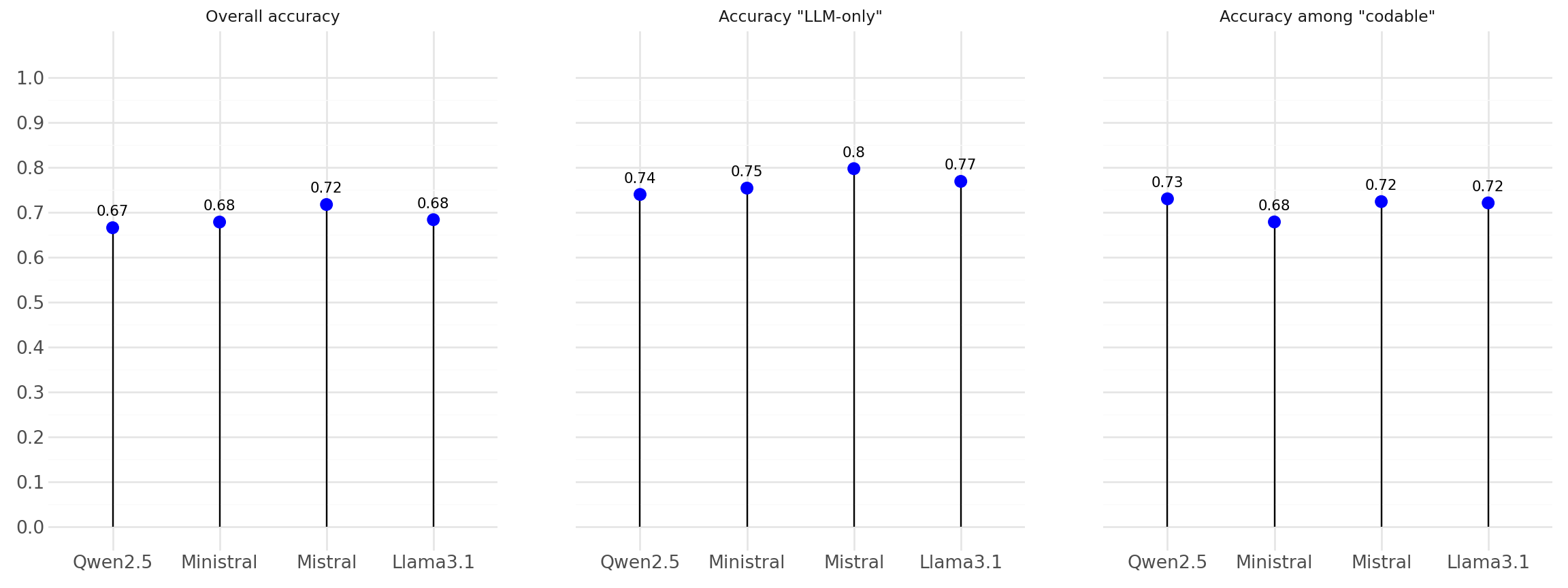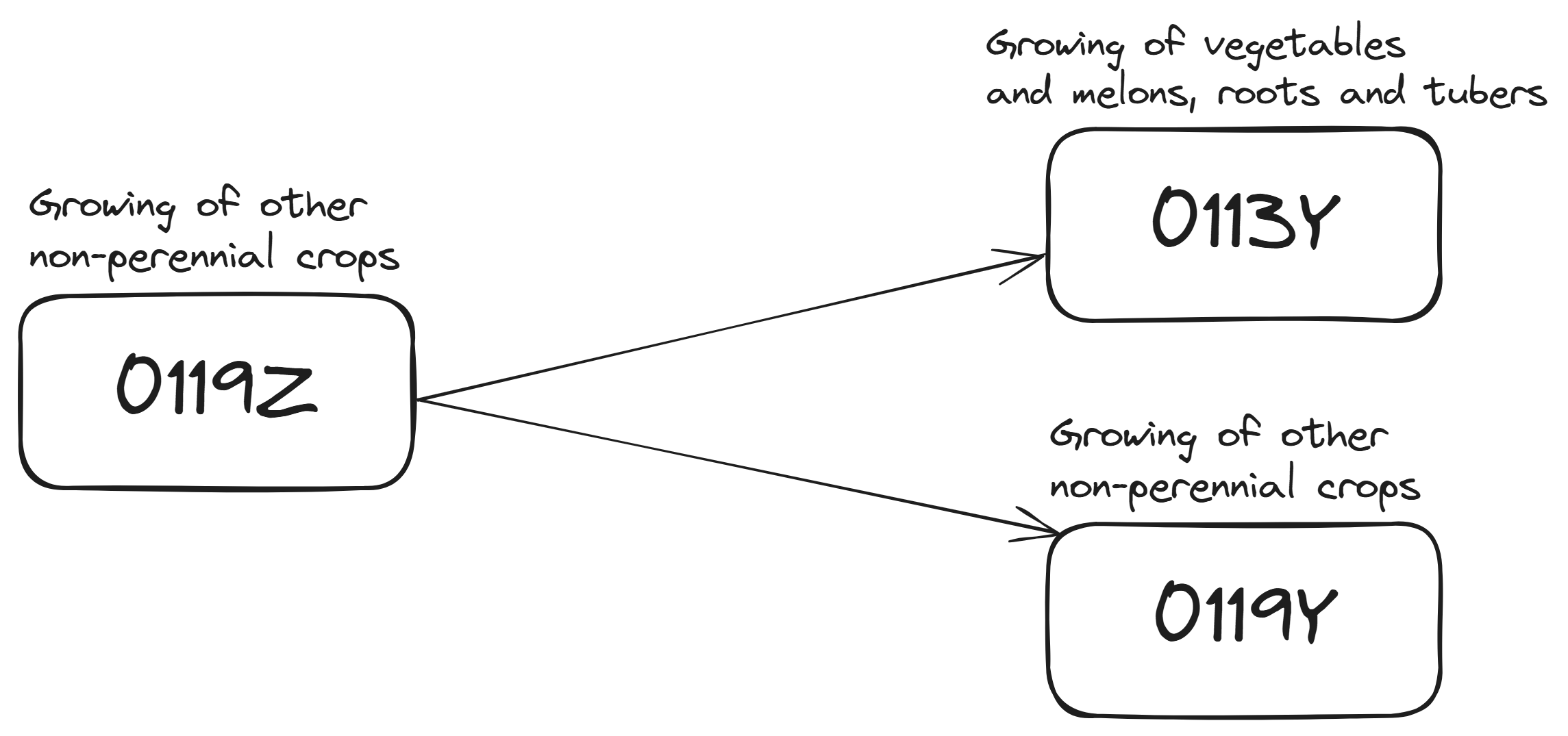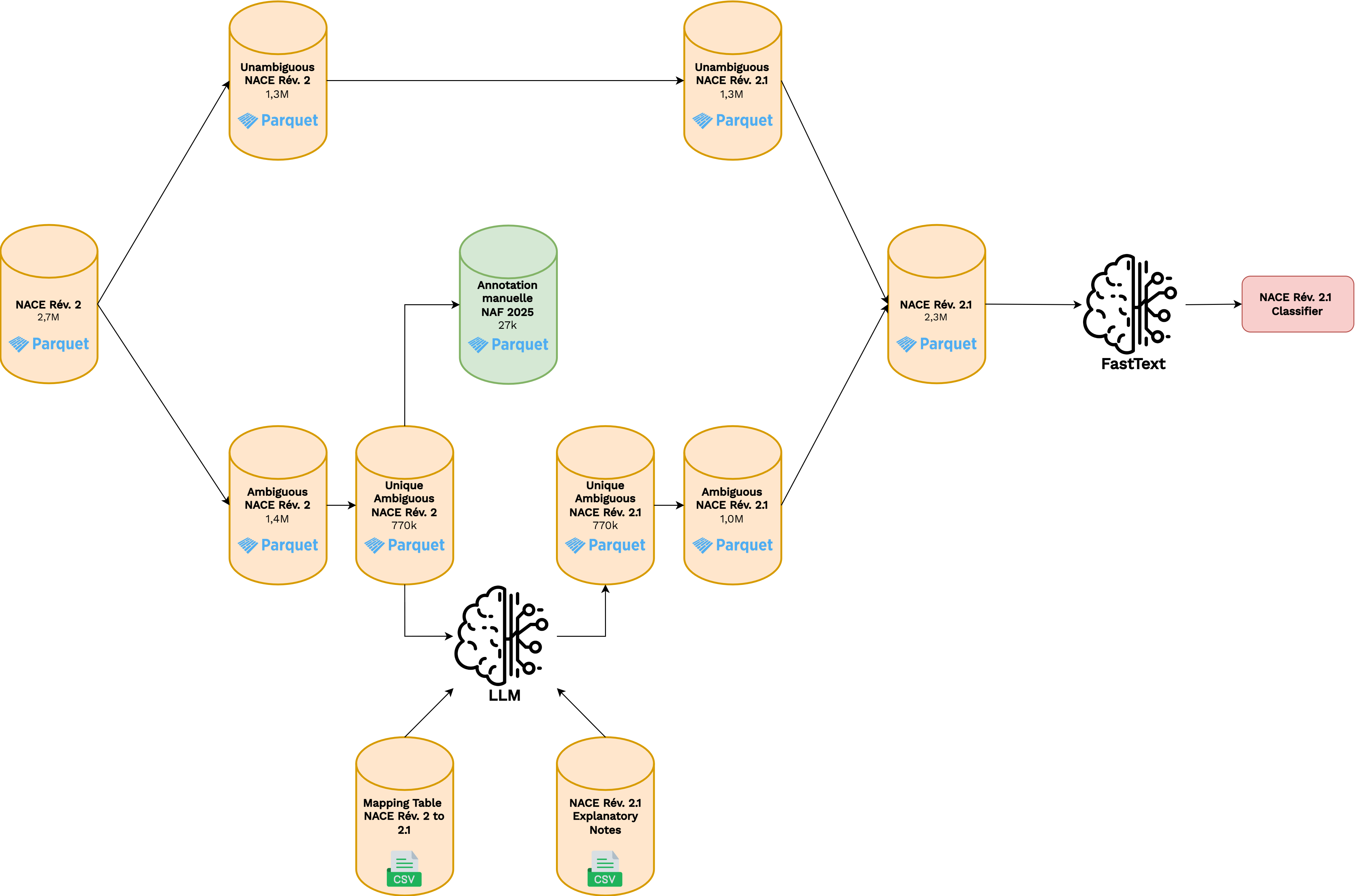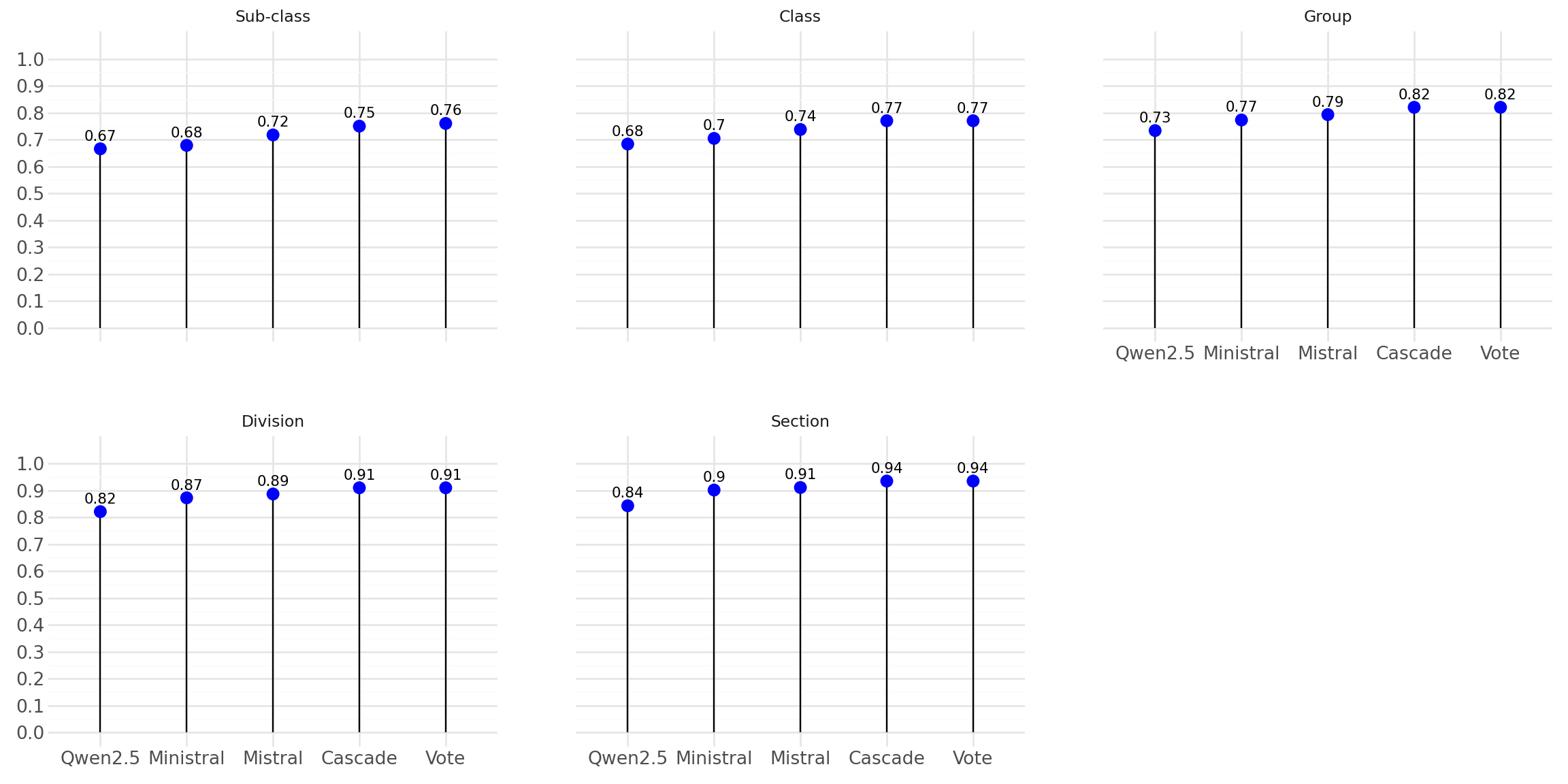
Ongoing automatic coding projects at Insee
Plan
Dual presentation:
- Relabeling training sets in a new nomenclature (cluster 5)
- Modernize the model using PyTorch in production (cluster 4)
Retraining a traditional ML model in production using LLM
1️⃣ Introduction
ML Model Robustness
- ML models are trained using reference datasets tailored for a specific task.
- In practice, real-world data often drifts over time from these reference datasets ➡️ performance degradation?
- Regular retraining becomes essential.
- A particularly challenging case in official statistics is the change in the classification.
2️⃣ Transition towards NACE Rév. 2.1
Timeline for Adoption 🗓️
- Phased adoption approach:
- 2025 ➡️ dual labeling in both NACE Rév. 2 and 2.1
- 2026 ➡️ improving the NACE Rév. 2.1. classifier model
- 2027 ➡️ full NACE Rév. 2.1 classification while maintaining legacy NACE Rév. 2 codes for specific usages.
What’s New in NACE Rév. 2.1?
- At level 5: 746 sub-classes compared to 732 before.
- Mainly fine-grained splits at class level (level 4), but not exclusively.
- 551 unambiguous mappings, i.e., one-to-one correspondence ➡️ ideal case! 👌

Ambiguous Cases
- 181 ambiguous mappings, i.e., one-to-many ➡️ challenging! 🚩
- Requires expert review for proper recoding.

Show distribution of ambiguous codes
| 1-to-N | # occurence |
|---|---|
| 2 | 109 |
| 3 | 30 |
| 4 | 24 |
| 5 | 6 |
| 6 | 4 |
| 8 | 1 |
| 9 | 2 |
| 21 | 1 |
| 27 | 1 |
| 36 | 1 |
| 38 | 2 |
Multiple Challenges
- Need to recode the stock of the registry forms ➡️ over 14 million entries.
- Building a classifier for new data flow requires a clean stock base as a training dataset.
- Previous fastText model trained on over 10 million labeled entries.
- Performance is highly sensitive to training data volume.
Available Data
- Old registry dataset: \(~10\) million entries, but poorly suited for new labels.
- New registry dataset: \(~2.7\) million entries.
- Unambiguous: \(1.3\) million, covering 504 sub-classes.
- Ambiguous: \(1.4\) million, covering 177 sub-classes.
- Manual annotation campaign is critical.
Annotation Campaign
- Annotation launched since mid-2024.
- Focused on uniquely ambiguous cases.
- 🎯 Dual objectives:
- Assign a NACE Rév. 2.1 code 🚀
- Assess NACE Rév. 2 code quality 🗸
- Current count: \(~27k\) annotated entries… still insufficient!
3️⃣ Methodology applied
Methodology
- 🎯 Goal: Build the most comprehensive training dataset possible.
- One-shot experimentation ➡️ not intended for production reproducibility.
- Leveraging LLMs for automated NACE Rév. 2.1 labeling.
- Data used:
- New registry stock dataset (\(~2.7M\) records)
- Mapping table from NACE experts
- NACE explanatory notes
- Manually annotated data (\(~27k\) entries)
Methodology

Leveraging LLMs
- Augmented Generation (RAG/CAG) vs fine-tunning
- RAG: Unstructured prior knowledge based on similarity of notes embeddings
- CAG: Structured prior knowledge based on known mappings
- 💡 Core idea ➡️ Provide key information to the LLM to translate NACE Rév. 2 into 2.1
Warning
RAG can act like a zero-shot classifier, while CAG is not a classifier as it relies on prior knowledge.
Prompt Design
A common system prompt for all entries
Afficher le prompt sytème
Tu es un expert de la Nomenclature statistique des Activités économiques dans la Communauté Européenne (NACE). Tu es chargé de réaliser le changement de nomenclature. Ta mission consiste à attribuer un code NACE 2025 à une entreprise, en t'appuyant sur le descriptif de son activité et à partir d'une liste de codes proposés (identifiée à partir de son code NACE 2008 existant). Voici les instructions à suivre: 1. Analyse la description de l'activité principale de l'entreprise et le code NACE 2008 fourni par l'utilisateur. 2. À partir de la liste des codes NACE 2025 disponible, identifie la catégorie la plus appropriée qui correspond à l'activité principale de l'entreprise. 3. Retourne le code NACE 2025 au format JSON comme spécifié par l'utilisateur. Si la description de l'activité de l'entreprise n'est pas suffisamment précise pour identifier un code NACE 2025 adéquat, retourne `null` dans le JSON. 4. Évalue la cohérence entre le code NACE 2008 fourni et la description de l'activité de l'entreprise. Si le code NACE 2008 ne semble pas correspondre à cette description, retourne `False` dans le champ `nace08_valid` du JSON. Note que si tu arrives à classer la description de l'activité de l'entreprise dans un code NACE 2025, le champ `nace08_valid` devrait `True`, sinon il y a incohérence. 5. Réponds seulement avec le JSON complété aucune autres information ne doit être retourné.Each observation gets a custom prompt including:
- Business activity description
- Original NACE Rév. 2 code (in CAG)
- Candidate codes list from retriever
Instruction on output format required.
Output Validation
- LLMs tend to be overly verbose
- Responses shaped into structured, minimal format
- JSON is the preferred schema.
- Response parsing:
- Format check
- Detecting hallucinations
4️⃣ Results
Evaluation Challenge
❓ Key question: How to evaluate an LLM?:
Classification seems simpler… but complexity of taxonomy matters.
Used \(27k\) manual annotations as the benchmark 🥇
3 performance metrics:
- Overall accuracy
- Accuracy among codable entries
- Accuracy of LLM only
Performance of models
Reconstructing Ambiguous Dataset
- 💡Idea: Treat LLMs as additional annotators
- ❓Can we boost performance via ensemble methods?
- Built 3 more annotations:
- Cascade selection
- Majority vote
- Weighted vote
Annotation Fusion

Retraining with NACE Rév. 2.1
- Rebuilt new registry dataset with NACE Rév. 2.1 (~2M records)
- Data distribution unchanged
- New registry variables used
- Achieved comparable performance to NACE Rév. 2 model
Retraining Accuracy

PyTorch in production: why and how ?
1️⃣ Current situation
fastText on production, but outdated ?
- fastText: a powerful and efficient model currently used in production for NACE coding at Insee…
- … but the library repo has been archived on March 19th, 2024
This non-maintenance is highly problematic in the medium-term:
- Potential appearance of (non-fixable) bugs
- Conflicting versions of dependencies
- Modernization hindrance
2️⃣ Towards PyTorch-based models…
PyTorch: why ? Some strategic reflections…
💡 Idea: Develop our custom PyTorch-based model to:
- adapt and customize the architecture for our specific needs (text classification with additional categorical variables)
- limit dependencies to external libraries and internalize maintenance for more robustness in the long-term
- access to the vibrant deep learning / NLP community to develop additional features (explainability with Captum, calibration with torch-uncertainty…)…
- … or use pre-trained models on Hugging Face
Our solution: the torchFastText package
The package:
- Provides a standard yet flexible architecture for automatic coding needs…
- … that stays close to the fastText methodology for now but is led to evolve
- Distributes the raw PyTorch model, a Lightning module as well as a wrapper class for a quick grip
- Is open-sourced and aims at fostering collaboration ! Feel free to raise an issue, report a bug or open a PR.
PyTorch model & Lightning module
from torchFastText.model import FastTextModel, FastTextModule
import torch
model = FastTextModel(embedding_dim=80,
num_classes=732,
num_rows = 20000,
categorical_vocabulary_sizes=[10, 20],
categorical_embedding_dims=5
)
module = FastTextModule(
model=model,
loss= torch.nn.CrossEntropyLoss(),
optimizer=torch.optim.Adam,
optimizer_params={"lr": 0.001},
scheduler = None,
scheduler_params=None
)
print(model)
print(module)FastTextModel(
(embeddings): Embedding(20000, 80, padding_idx=0, sparse=True)
(emb_0): Embedding(10, 5)
(emb_1): Embedding(20, 5)
(fc): Linear(in_features=85, out_features=732, bias=True)
)
FastTextModule(
(model): FastTextModel(
(embeddings): Embedding(20000, 80, padding_idx=0, sparse=True)
(emb_0): Embedding(10, 5)
(emb_1): Embedding(20, 5)
(fc): Linear(in_features=85, out_features=732, bias=True)
)
(loss): CrossEntropyLoss()
(accuracy_fn): MulticlassAccuracy()
)Tokenizer
from torchFastText.datasets import NGramTokenizer
training_text = ['boulanger', 'coiffeur', 'boucherie', 'boucherie charcuterie']
tokenizer = NGramTokenizer(
min_n=3,
max_n=6,
num_tokens= 100,
len_word_ngrams=2,
min_count=1,
training_text=training_text
)
print(tokenizer.tokenize(["boulangerie"])[0])[['<bo', 'bou', 'oul', 'ula', 'lan', 'boul', 'nge', '<boul', 'eri', 'rie', 'ie>', 'boul', 'boul', 'oula', 'ulan', 'lang', 'ange', 'nger', 'geri', 'erie', 'rie>', '<boul', 'boula', 'oulan', 'ulang', 'lange', 'anger', 'ngeri', 'gerie', 'erie>', '<boula', 'boulan', 'oulang', 'ngerie', 'langer', 'angeri', 'ngerie', 'gerie>', '</s>', 'boulangerie </s>']]The wrapper class
A quick way to launch a training in two lines of code.
from torchFastText import torchFastText
# Initialize the model
model = torchFastText(
num_tokens=1000000,
embedding_dim=100,
min_count=5,
min_n=3,
max_n=6,
len_word_ngrams=True,
sparse=True
)
# Train the model
model.train(
X_train=train_data,
y_train=train_labels,
X_val=val_data,
y_val=val_labels,
num_epochs=10,
batch_size=64
)
# Make predictions
predictions = model.predict(test_data)3️⃣ … in production
Some obstacles:
Being a general framework, PyTorch-based models are slower than the original fastText library.
- ⚡ Better to have GPU for high-scale training in reasonable time
- ☢️ A constraint: CPU-bound inference in production. Requires to be extremely careful regarding size of the model and pre-deployment tests.
First step has been to train a model small enough to have a response time lower than 400 ms on CPU, while keeping high prediction accuracies.
Deployment stack
MLFlow is at the core of the pipeline:
- Classicly: model life cycle incl. training monitoring, evaluation metric logging, model versioning…
- And also fast deployment using a PyFunc wrapper specifically designed by MLFlow
FastAPI for API development, and Pydantic for data validation. API is deployed on a Kubernetes cluster.
Conclusion and next steps
- ⚠️ Transitioning to PyTorch in production requires care to deploy in production…
- 👐 … but enables to open many doors: modernization, better maintenance, state-of-the-art technology… It’s well worth it !
Next steps include:
- More complex architectures: attention mechanisms, more layers… - to improve on the fastText methodology
- Use HuggingFace: pre-trained models, tokenizers (or train a new tokenizer)
- Better handling of uncertainty: calibration and conformal prediction